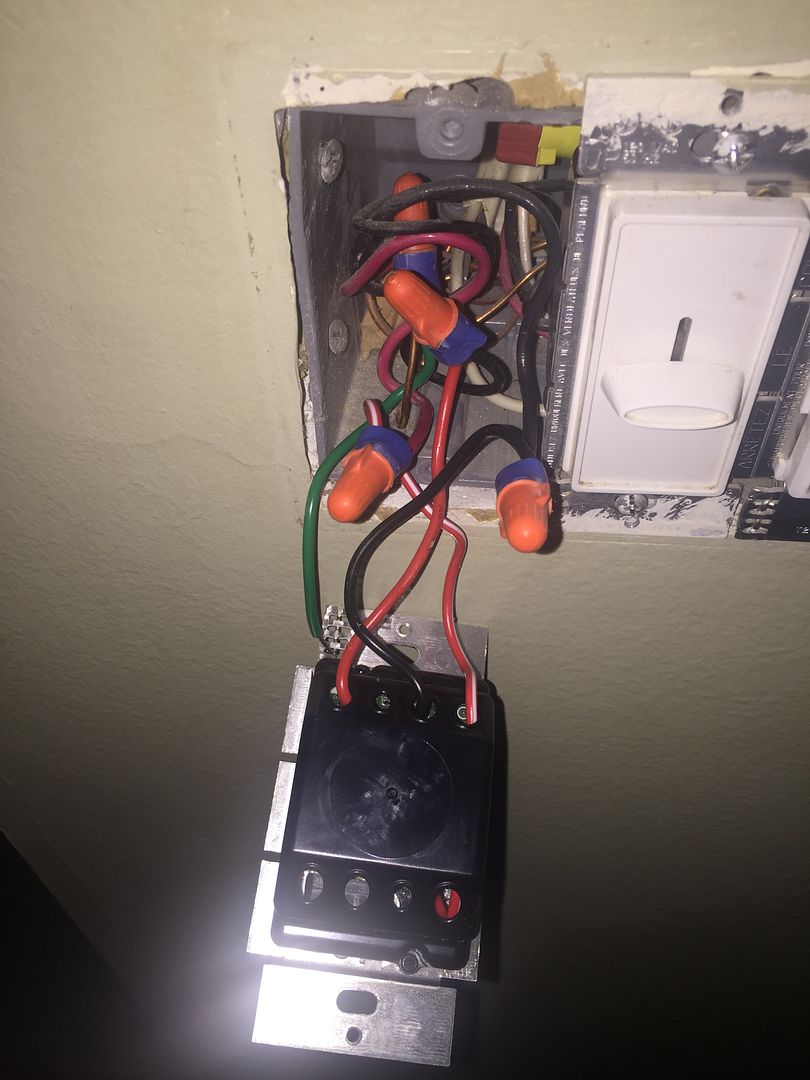Our kitchen light is controlled by two light switches, a conventional switch and a dimmer. Has been since we moved in. The Dimmer switch took a dump, prompting a trip to the cursed land of the orange-aproned now-nothings.
I picked out a switch that can dim LEDs, and can be used as a three-way switch.
When I pulled the switch and compared the two, the wire colors on the switch were different, so I matched up the wire position (coming out of the box).
None of the wires in the wall had electrical tape on them to indicate it was a traveler wire BTW.
Now, when you turn the dimmer switch on, the light flickers on, then off very quickly, then stays on. The other switch that controls the lights (conventional switch) only works if the dimmer is in one position.
How do I determine the traveler wire? Pull both switches and use a DMM to find continuity? Just randomly switch wires, Russian Roulette style until there's no sparks? Should I sell the house and move to a tiny house and make my underwear from hemp?
That last option was to appease my wife. She would do that.
Anyway, in case it helps, here's a pic of whats in there now

It's hard to tell from the picture, but if you can find two wires that attach to the switch and are in the same cable (a 3 wire cable not counting the ground wire) those are the travelers. The third wire on the switch should go to a 2 wire cable (again not counting the ground). That wire is either the source or goes to the lights.
Chris
Recently went thru the same thing when I changed out the ceiling fans in my kitchen and dining room. Turns out they make regular dimmer switches and three way dimmer switches. I started by finding the wire that power comes into the box from the breaker and the neutral bundle of whites. By wire nutting different wires together and going to the other switch, I could use a multimeter to figure out what wires went where. Mine was further complicated because they were all cloth covered wires, and they all looked the same. Three separate switch boxes with 2, 3, and 3 switches respectively switching two fans and 4 lights.
I got it fixed. The traveler wires we're marked. With the help of a multileter I figured out what was up and wired it on correctly.
Then, still, when the lights turned on they would flicker once then stay on. The LEDs said they were dimmable, but they are older ones. I suspect they were not really dimmable. We never dim these lights anyway, so I saved $22 and I put a non-dimming in. Works correctly now.
Spitsix wrote: You have to make sure that the dimmer switch is also led compatible.
no disrespect, but I believe this is incorrect. As long as the LEDs are dimmable then I think any functioning dimmer switch will operate it
No, splitsix is correct. Dimmers that are able to dim LEDs and CFLs have an adjustment, like gain on an amplifier. The way I understand it is an incandescent bulb runs on 120V. To dim that bulb you don't need to drop much voltage to get it to dim. Basically, a relatively small drop in voltage (electrical pressure) will reduce the current (electron flow) a relatively large amount.
LEDs and CFLs use much less current to operate. Therefore, if a non LED dimmer is used, the lowest setting on the dimmer will provide enough current for an LED or CFL to operate at nearly full power.
I bet I'm totally wrong here and will look foolish in a few minutes...
DrBoost wrote: No, splitsix is correct. Dimmers that are able to dim LEDs and CFLs have an adjustment, like gain on an amplifier. The way I understand it is an incandescent bulb runs on 120V. To dim that bulb you don't need to drop much voltage to get it to dim. Basically, a relatively small drop in voltage (electrical pressure) will reduce the current (electron flow) a relatively large amount. LEDs and CFLs use much less current to operate. Therefore, if a non LED dimmer is used, the lowest setting on the dimmer will provide enough current for an LED or CFL to operate at nearly full power. I bet I'm totally wrong here and will look foolish in a few minutes...
That's good to know and makes perfect sense, I put LEDs in my current house and luckily didn't have to change a single thing except the bulb. Everything in my house pre-dates LEDs, but that is the only experience I have.
Some non LED rated dimmer will work just fine with LED's and some won't. I had to replace 2 dimmers because no matter how low you set it an LED would still glow light up some. A couple other dimmers (actually older) work just fine.
The odd thing with this situation is, I have dimmable LEDs and installed an appropriate switch. But the wouldn't dim. I got them from the HD clearance rack. I suspect they are older, or lower quality or both.
Just a tid bit to share from work experience- I have run into dimmers and ballasts/lamps that have compatibility limitations.
So say you try to replace a Lutron brand dimmer with a Hubbel brand, and the system that worked before you fixed it suddenly does not.
Product literature should specify this though.
paranoid_android74 wrote: Just a tid bit to share from work experience- I have run into dimmers and ballasts/lamps that have compatibility limitations. So say you try to replace a Lutron brand dimmer with a Hubbel brand, and the system that worked before you fixed it suddenly does not. Product literature should specify this though.
No kidding!? Good to know.
You'll need to log in to post.